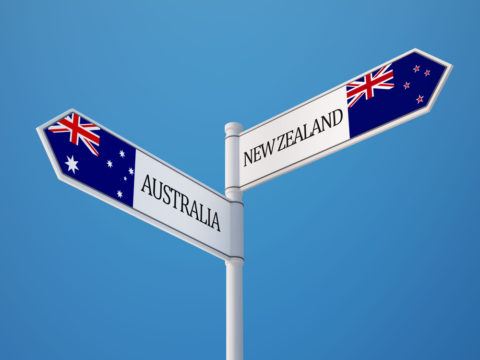Australia and New Zealand
to reopen borders for
international travel
8 February 2022
The authorities in Australia and New Zealand have announced their respective plans to ease COVID-19 travel restrictions and reopen their borders to international travel.
Both countries have implemented extremely tough measures throughout the pandemic to help fight the spread of the virus, including enforcing some of the world’s strictest border controls to limit the movement of people in and out of the country.
As a result, both Australia and New Zealand have managed to keep infection and death rates relatively low compared to other countries with less stringent border controls. However, both countries have recently announced plans to relax the rules and allow foreign nationals to enter under certain conditions.
Below, we set out the reopening plans for both Australia and New Zealand, and provide an overview of what the new rules will be for those travelling to either destination in the near future.
Australia
Australia has had some of the world’s strictest border controls in place throughout the pandemic, closing its borders in March 2020 and even preventing its own citizens from leaving the country last year. During the closure, most foreign nationals were barred from entering the country, although some international students and skilled migrants have been permitted to enter since last December.
Australia has so far recorded more than 2.7 million cases of coronavirus and more than 4,240 deaths, with almost 80% of the population now fully vaccinated.
New plans to lift restrictions from 21 February will mean that double vaccinated tourists and other visa holders from anywhere in the world will be able to travel to Australia for the first time in almost two years.
Under the new rules, those travelling to Australia will need to provide proof of double vaccination to be granted entry. Unvaccinated travelers with medical proof that they cannot be vaccinated will still need to apply for a travel exemption and, if successful, will be required to quarantine at a hotel on arrival.
Announcing the reopening plans, Prime Minister Scott Morrison said: “If you’re double vaccinated, we look forward to welcoming you back.”
Morrison also took the opportunity to reaffirm the importance of travellers being able to provide proof of their vaccination status, alluding to recent events regarding tennis player Novak Djokovic who had his Australian visa cancelled and was deported from the country last month due to his refusal to be vaccinated. The Prime Minister said: “Events earlier in the year should have sent a very clear message, I think, to everyone around the world that that is the requirement to enter into Australia.”
Despite most of the country lifting restrictions, the state of Western Australia (WA) still has tough measures in place. Under WA’s new hard border arrangements, approved travellers are permitted to enter with testing and quarantine requirements. More information on the specific entry rules for WA can be found here.
Australia’s reopening will be welcome news for many sectors, particularly for the tourism industry which is estimated to have lost £53bn during the pandemic.
New Zealand
Like its close neighbour Australia, New Zealand has operated a closed-border policy for nearly two years in a bid to keep out coronavirus. As a result of the strict measures, the country of five million people has reported very low case numbers, with around 17,000 COVID-19 cases and just 53 deaths reported. It is estimated that around 94% of the country’s population over the age of 12 is now fully vaccinated and 56% of eligible people have had their boosters.
But while the closed-border policy has been popular with residents, many New Zealand nationals have been stranded overseas and unable to return home. Following growing criticism of the policy, New Zealand has announced a phased reopening of its borders and a five-step plan to resuming international travel.
The key elements of the plan are as follows:
- Step 1: From 27 February 2022, fully vaccinated New Zealanders from Australia can return home. Citizens will not need to undergo mandatory hotel quarantine, but will still need to self-isolate at home for 10 days.
- Step 2: From 13 March 2022, fully vaccinated citizens from all other countries can enter New Zealand. This includes skilled foreign workers earning at least 1.5x the median wage, travellers on a working holiday scheme and partners and dependant children of New Zealand citizens and residents.
- Step 3: From 12 April 2022, up to 5,000 international students and current offshore temporary visa holders with a valid visa will be permitted to enter from anywhere in the world.
- Step 4: From July 2022, all Australians and all other visitors from countries who do not require a visa will be able to enter. Individuals arriving under the Accredited Employer Work Visa categories will also be permitted.
- Step 5: From October 2022, all visa categories will reopen, including visitor and student visas.
10-day self-isolation is only available for fully vaccinated travellers who are eligible to enter New Zealand. Unvaccinated New Zealand citizens and those who do not meet New Zealand’s vaccination requirements for self-isolation will continue to enter managed isolation and quarantine (MIQ).
New Zealand Prime Minister Jacinda Ardern said: “Opening back up in this managed way balances inflows of travellers so people can reunite and fill our workforce shortages, while also ensuring our healthcare system can manage an increase in cases.”
More information on New Zealand’s five-step plan can be found here.
Planning travel to Australia or New Zealand?
Those who intend to take advantage of the border reopening and plan to travel to Australia or New Zealand for tourism or business purposes should check if they need a visa.
Smith Stone Walters’ Global Immigration team can assist with the visa application process and advise on the latest entry requirements for your stay. To speak to a member of the team, please contact us today.
Share story

